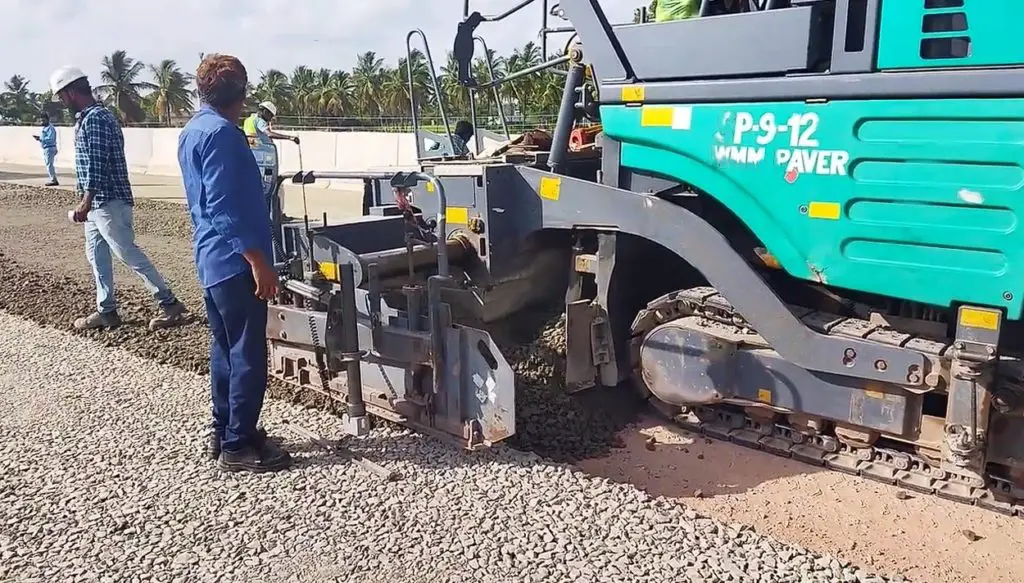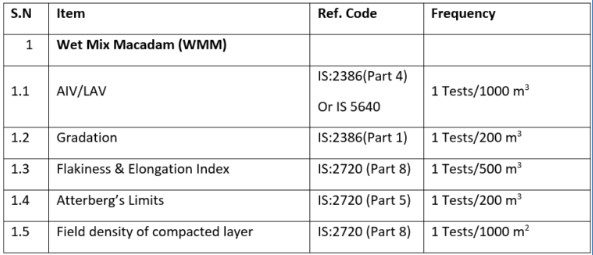Discover the process of the Macadam Wet Mix Method Statement and revolutionize your paving works. Read the full article and get ahead!
Table of Contents
Method Statement for Macadam Wet Mix
Wet Mix Macadam is produced by laying, spreading, and compacting clean, crushed, and well-graded granular materials on a prepared and approved Granular sub-Base. The material is thoroughly combined with water before being rolled into a dense mass.
It shall be laid on one or more layers in accordance with the drawing’s line and level, grade, and cross-section, or as instructed by the Engineer. The thickness of a single compacted Wet Mixed Macadam (WMM) Base must be at least 75 mm. With Engineer’s permission, the maximum thickness of a single compacted layer base can be up to 250 mm.
Reference
Specifications of the Ministry of Road Transport and Highways
Technical Specifications
Relevant Drawings
Setting Out
After the GSB Sub-Base layer has been approved, line and surveying level work are carried out to fix the Wet Mix Macadam base layer (hence referred to as WMM Base). Pegs are placed at regular intervals on the safe side of the road edge so that the blade of the grader does not disrupt the peg when mixing the base materials.
The top level of the Base layer is marked on each peg. Outside the limits of construction zones, the chainage boards and work benchmarks must be placed.
Material Selection
Aggregates
Crushed stone or crusher run shall be used for coarse aggregate in accordance with the project specification.
Physical Requirements
The aggregate elements must be produced by an integrated crushing and screening plant (Impact or Cone type), and crushing must be carried out in at least two stages unless otherwise advised by the Engineer.
Only crusher-run screening shall be used for the fraction of material passing through a 4.75mm sieve.
If the water absorption value test of coarse aggregate is greater than 2%, the soundness test must be carried out on the aggregate delivered to the site. The materials must conform to the physical standards outlined in the project specifications.
Grading Criteria
The aggregate must conform to the grading specified in the technical specification. Plasticity Index (PI) less than 6 is required for materials finer than 425 microns.
The final gradation approved within these limits must be well graded from coarse to fine and must not vary from one sieve’s low limit to another sieve’s high limit or vice versa.
Resources
The Wet Mix Macadam (WMM) requires the following equipment to be carried out.
Macadam Plant with Wet Mix
Tippers / Dumpers
Vibra Roller (80-100 KN)
Water tanker
Paver with a width of more than 9 meters
Survey instrument/kit
Operating Procedure – Macadam Wet Mix Method Statement
WMM Base Preparation
5.1.a Adequate lateral confinement of aggregates
During laying, proper arrangements must be made for the lateral containment of the wet mix. This will be accomplished by putting materials on the adjoining shoulder beside the WMM layer.
The preparation of the mix, spreading of the mix, and compaction are all done in order.
The operation sequence must be followed as indicated in the project specifications.
Preparing the Mix
Wet mix Macadam shall be prepared in an approved WMM mixing facility with provisions for regulated water input and forced/positive mixing. After replacing the aggregate fraction maintained on the 22.4 mm sieve with materials passing from 22.4 and retained on 4.75 mm, the optimal moisture for mixing shall be established.
Evaporation loss must also be considered while adding water. The blended substance must be evenly wet, with no segregation permitted.

Mix Spread
The aggregate must be put properly and evenly on the approved GSB layer immediately after mixing. Materials should not be piled up or hauled over a partially constructed length. The first layer will be laid with a motor grader, and the second layer mix will be dispersed with a WMM paver finisher capable of paving widths ranging from 4.5m to 9.0m.
During construction, the layer can be tested using a depth block. There is no allowed segregation of materials. The aggregates should have a consistent gradation with no pockets of fine materials.
Compression
Compaction is carried out with a suitable roller to the full depth once the mix has been laid on the site to the required thickness, grade, and camber. Compaction must be done with a vibratory roller of 80 to 100 KN static weights with a plain drum or an equivalent capacity roller with a thickness of up to 200 mm in a single layer.
Rolling is done longitudinally from the lower edge to the upper edge for the segment with unidirectional cross-fall and superelevation.
Each roller pass must overlap not less than one-third of the track made in the previous run. During rolling, the grade and cross-fall must be monitored, and any high spots or depressions that appear must be addressed by adding or removing new materials.
The roller’s speed must not exceed 5km/h. Rolling should be continued until the layer’s density reaches 98% of its maximum dry density.
When the WMM layer is soft or yielding, or when it generates a wave-like motion, rolling should be avoided. If the level difference or irregularities during rolling exceed 12 mm when tested with a 3-meter straight edge, the surface should be loosened and premixed materials added or removed as necessary before rolling again.
In no case should unmixed material be permitted to fill the depressions.
Traffic Opening
The road must be allowed to dry for 24 hours after assessing the compaction and level of the WMM course. No vehicular traffic should be allowed on the finished WMM surface until it has dried and been coated with a wearing course.
Quality Assurance
Table 400-12 Physical coarse aggregate requirements for Wet Mix Macadam Sub-base/Base Courses

Wet Mix Macadam Sub Base / Base

Table 400-13: Aggregate Grading Requirements for Wet Mix Macadam

Control Tests for Granular WMM Base: Post Construction
Tolerance in Surface Level: +10 mm
Permissible undulation (with 3 m straight edge): 8 mm
No. of undulations permitted in any 300 m length, exceeding 12 mm: 20
The quality of materials and work shall be controlled in accordance with the project requirements.
A location-specific safety strategy will be provided.
Environmental Security
Nearby streams, water courses, lakes, and reservoirs must be safeguarded from contamination caused by soil erosion from excavation sites by erecting temporary berms, dykes, sediment basins, slopes, and drains, as well as using temporary mulches, seeding, or other control measures.
Vehicle tracks must be kept moist to prevent dust particles from flying while the vehicle moves.
tag: Macadam Wet Mix Method Statement

